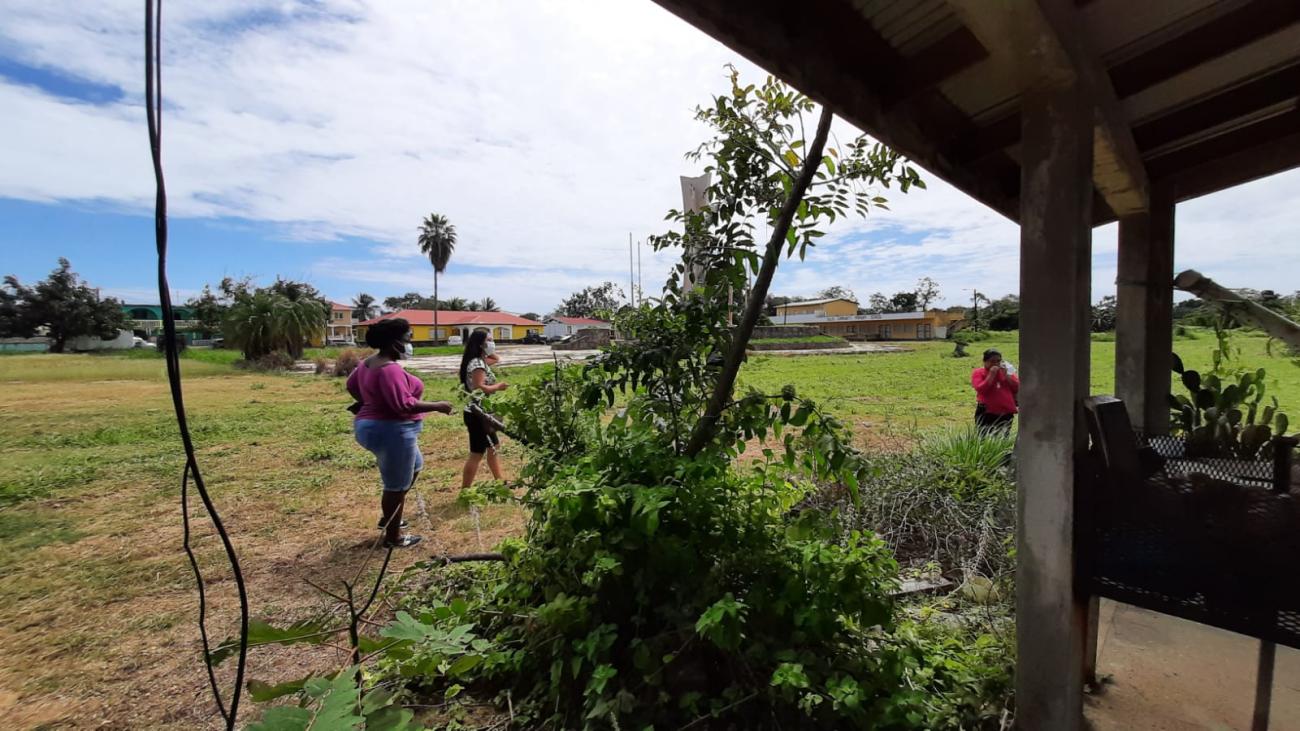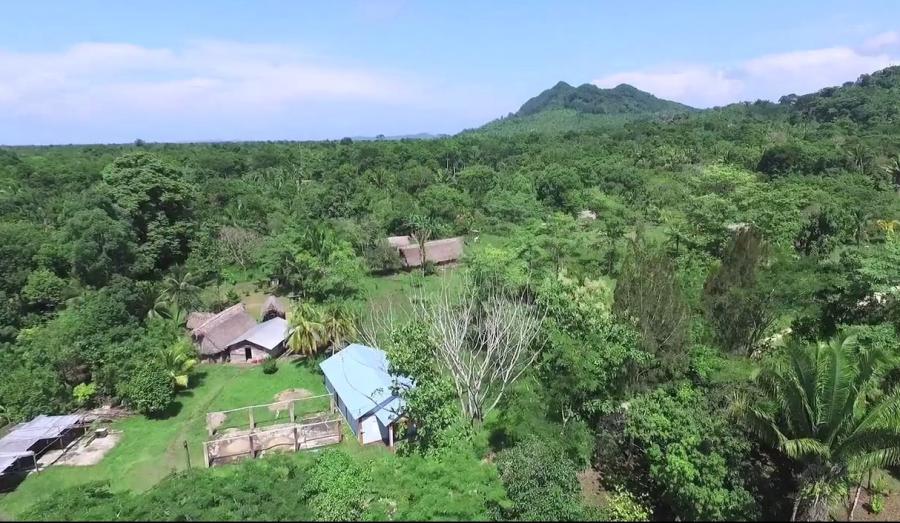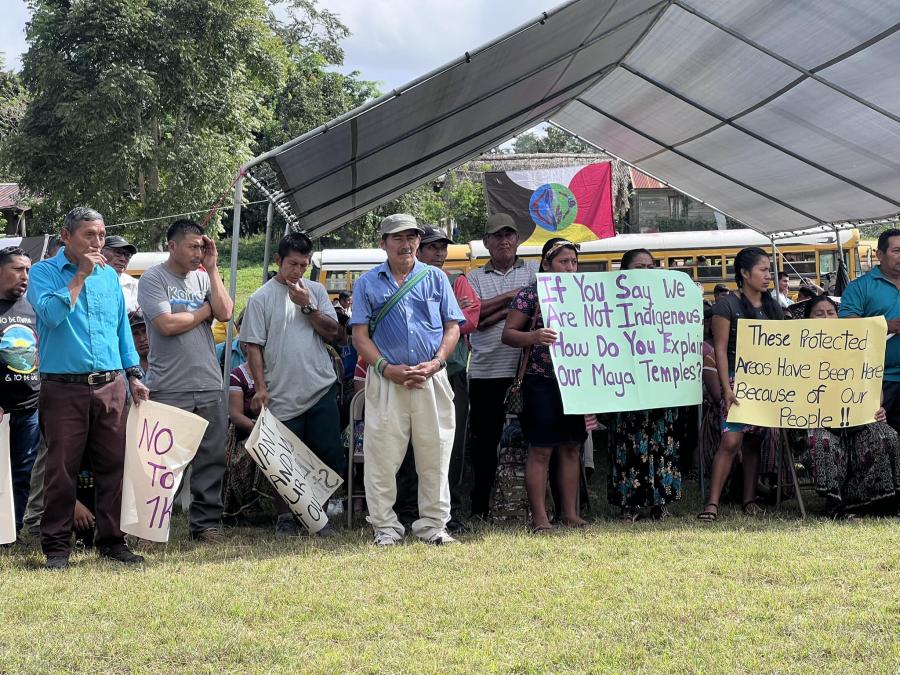
In March 2021, the National Garifuna Council launched their initiative, "Food Sovereignty for the Garifuna people of Belize." The project’s mission was to create productive, small-scale green spaces to enhance food security and build community health for the Garifuna Peoples in Dangriga and the larger Stann Creek District of Southern Belize. With the support of Cultural Survival’s Keepers of the Earth Fund, the Indigenous-led project has strengthened the health, economic sustainability, and cultural traditions of the Garifuna. The majority of Garifuna communities in Dangriga Town, Hopkins, Georgetown, Seine Bight, Punta Gorda Town, and Barranco, have been in danger of losing vital aspects of their culture and often face discrimination from the wider Belizean population. In order to address this issue, the National Garifuna Council has established a medicinal herb garden and a cassava farm that provide job opportunities and restore traditional ways of life for the Garifuna.
Cassava has been a staple food for generations and is an important, multi-purpose element of the Garifuna diet and culture. As part of the training program at the Cassava Processing Demonstration Centre, several persons from the community learned the skills associated with cassava land preparation including clearing, plowing, harrowing, chambering, planting, and harvesting. Commenting on the cassava making process, Ifasina Efunyemi, a community trainee, said, "It is very rewarding to go and actually experience something like that. It shows us the opportunity we have as a people to really utilize what we have around us, our produce, and all that we can possibly do with our produce to make money from it, not only for our own consumption but for the benefit of others, to export, to have available on the local market, to provide something of high quality that would be beneficial healthwise to us and also economically."
Cassava flour is a staple that is in demand both in and outside of Belize, with a growing market in the United States. Selling products domestically and internationally has contributed to the economic sustainability and autonomy of Garifuna communities. What’s more, the herbal medicine garden has given the majority of Garifuna access to affordable traditional medicines and spices that their ancestors once utilized. This is a direct positive impact of the project because the hospitals and medical centers in Southern Belize are frequently short on supplies, forcing Garifuna communities to depend on their own resources. The construction of greenhouses provided space for the planting of herbs where community participants were able to contribute to the gardening, as well as give recommendations and feedback on the process.
Spread across two acres of land, a plant nursery was also developed for the cultivation of other food products and spices that now serve as seed banks for local farmers and individuals for their home gardens. Some of the food plants that have been cultivated are bitter cassava tuber, yuca (sweet cassava), yams (yellow, white, and soup), sweet potatoes, dasheen (eddoes), plantain, banana, blogo, okra, sweet pepper, and tomatoes. Some of the herbs include neem, basil, cilantro, oregano, mint, yellow ginger (turmeric), ginger, lemongrass, and more. The products from the greenhouses and plant nursery are grown organically and sold within the community at an affordable price for sustainability.
Marvin Blades, the Ministry of Agriculture Extension Officer, said, “This project was a timely one, as it sought to increase the involvement and participation of Garifuna farmers and participants who only make up three percent of farmers in the Stann Creek District. Garinagu have, in the past, produced the majority of the staple cultural crops such as cassava, yams, plantain, and banana. This project begins to address the issues of seed availability, production, processing, and value, adding food security through home gardens and the participation of women and youths—a truly holistic approach in addressing farming for the Garifuna Community.”
The project addresses the social and environmental values of rebuilding relationships with nature while also promoting good health and stable employment. Professional jobs for young Garifuna people are often difficult to obtain; the majority of them depart from their homes in search of work in urban regions like Belmopan and Belize City, where they tend to adopt other cultures and veer away from their Garifuna origins, culture, use of language, customs, and beliefs. There are also young people who stay around idling by or doing small jobs when they become available. Due to a lack of employment, some of them become inactive citizens and engage in theft, vandalism, or other criminal activity. For this reason, the National Garifuna Council encourages youth to engage in traditional agricultural practices, with 50 percent of those involved with the project aged between 18 and 35. Youth are urged to use their free time volunteering on the project that may one day lead to paid employment. They are provided with skills training, certification programs, and proper agricultural and farming techniques for development so that they can be employable in technical fields and be productive in the community.
It is imperative that young people are at the center of this and future projects in order to sustain its momentum and continue strengthening the Garifuna culture. Kenrick Witty, Project Steering Committee Member, said that the project is a “good venture because it includes all the Garifuna communities in Belize. It is an opportunity for [participants] to learn a lot of things, including knowing how to cultivate vegetables, which will make them self-sufficient. And if they produce well and have extra harvest, they can enter the realm of entrepreneurship. [This] will enable them to be producers rather than just consumers and uplift themselves and their families. Lastly, it is an opportunity for us to work together as Garifuna like the 2021 theme for the [National Garifuna Council] November celebrations—‘Au Bun, Amürü Nu,’ or ‘I for You, You for Me’—and to put that into practice. By knowing how each other’s plants are doing, exchanging information and best practices, and communicating and learning from each other, we can build on the success and be a stepping stone for future projects, becoming confident in ourselves. I am very hopeful and wish that we continue to advance together.” Thanks to their initiative, the National Garifuna Council has also been able to develop and improve partnerships with regional stakeholders such as the Ministry of Agriculture, Food Security and Enterprise, specifically the Ministry’s Stann Creek District Office.
Since its inception, the food sovereignty project has overcome numerous challenges, highlighting its resilience and readiness for long-term success. Many Garifuna communities were affected by Hurricane Iota’s heavy rains that led to flooding, especially in Dangriga and Hopkins. In Dangriga, the flooding completely destroyed the National Garifuna Council Cassava Demonstration farm plot. Equally disruptive, the COVID-19 pandemic led to curfews, vaccination mandates, and restrictions on movement. As a consequence, the National Garifuna Council decided to produce an educational training film so that communities could continue to be involved and share their findings and experiences. Following a discussion, it was also decided that a section of the training would cover COVID-19 symptoms and local remedies. Remarking on this, Francis Marin, a community participant, said that “the trainings [were] thoughtful, relevant, and timely. There is a need to increase participation of youth and women farmers, and for more publicity.”
This project is especially important and urgent to the Garifuna communities as the numbers of traditional healers are declining and the availability of medicinal herbs are becoming increasingly difficult to obtain. Young people are being sought for training to become traditional healers in an effort to move away from the commercialized pharmaceutical medicine of the Western world and revive Garifina cultural traditions. Significantly, 75 percent of Garifuna traditional healers are women, which aligns with Cultural Survival’s programmatic priorities of supporting projects that center women and enhance womens’ and girls’ leadership.
In 2021, the National Garifuna Council received a grant from the Keepers of the Earth Fund, an Indigenous-led fund at Cultural Survival designed to support Indigenous Peoples’ advocacy and community development projects globally. Since 2017, we have supported 238 projects in 38 countries through small grants and technical assistance, totaling $1,070,602. The funds go directly to Indigenous communities, collectives, organizations, and traditional governments to support projects designed by the communities and in accordance with their Indigenous values. Based on the United Nations Declaration on the Rights of Indigenous Peoples, we at Cultural Survival use a rights-based approach in our grantmaking strategies to support grassroots Indigenous solutions through the equitable distribution of resources to Indigenous communities.


